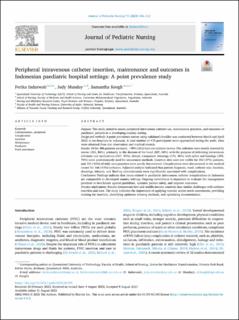| dc.contributor.author | Indarwati, Ferika | |
| dc.contributor.author | Munday, Judy | |
| dc.contributor.author | Keogh, Samantha | |
| dc.date.accessioned | 2023-10-23T11:01:44Z | |
| dc.date.available | 2023-10-23T11:01:44Z | |
| dc.date.created | 2023-09-15T10:29:16Z | |
| dc.date.issued | 2023 | |
| dc.identifier.citation | Indarwati, F., Munday, J. & Keogh, S. (2023). Peripheral intravenous catheter insertion, maintenance and outcomes in Indonesian paediatric hospital settings: A point prevalence study. Journal of Pediatric Nursing : Nursing Care of Children and Families, 73, 106-112. | en_US |
| dc.identifier.issn | 1532-8449 | |
| dc.identifier.uri | https://hdl.handle.net/11250/3098039 | |
| dc.description.abstract | Purpose: This study aimed to assess peripheral intravenous catheter use, maintenance practices, and outcomes of paediatric patients in a developing country setting. Design and methods: A point prevalence survey using validated checklist was conducted between March and April 2022 in ten hospitals in Indonesia. A total number of 478 participants were approached during the audit. Data were obtained from site observation and medical records. Results: Of the 386 patients surveyed, >90% (362) had one catheter in-situ. The catheters were mostly inserted by nurses (331, 86%), primarily in the dorsum of the hand (207, 54%) with the purpose of delivering intravenous infusions and medications (367, 95%). Simple transparent dressings (176, 46%) with splint and bandage (295, 76%) were predominantly used for securement methods. Insertion sites were not visible for 182 (47%) patients, and 151 (40%) of daily care practices were poorly documented. Complications were documented in the medical record for 166 (43%) catheters. Adjusted analysis indicated that patient diagnosis, ward, catheter size, location, dressings, infusate, and flushing administration were significantly associated with complications. Conclusions: Findings indicate that issues related to paediatric intravenous catheter complications in Indonesia are comparable to developed country settings. Ongoing surveillance is important to evaluate the management practices to benchmark against guidelines, optimise patient safety, and improve outcomes. Practice implications: Results demonstrate low and middle-income countries face similar challenges with catheter insertion and care. The study indicates the importance of applying vascular access needs assessments, providing training for inserters, identifying optimum dressing methods, and optimising documentation. | en_US |
| dc.language.iso | eng | en_US |
| dc.publisher | Elsevier | en_US |
| dc.rights | Attribution-NonCommercial-NoDerivatives 4.0 Internasjonal | * |
| dc.rights.uri | http://creativecommons.org/licenses/by-nc-nd/4.0/deed.no | * |
| dc.title | Peripheral intravenous catheter insertion, maintenance and outcomes in Indonesian paediatric hospital settings: A point prevalence study | en_US |
| dc.title.alternative | Peripheral intravenous catheter insertion, maintenance and outcomes in Indonesian paediatric hospital settings: A point prevalence study | en_US |
| dc.type | Peer reviewed | en_US |
| dc.type | Journal article | en_US |
| dc.description.version | publishedVersion | en_US |
| dc.rights.holder | © 2023 The Author(s) | en_US |
| dc.subject.nsi | VDP::Medisinske Fag: 700::Helsefag: 800::Sykepleievitenskap: 808 | en_US |
| dc.source.pagenumber | 106-112 | en_US |
| dc.source.volume | 73 | en_US |
| dc.source.journal | Journal of Pediatric Nursing : Nursing Care of Children and Families | en_US |
| dc.identifier.doi | https://doi.org/10.1016/j.pedn.2023.08.009 | |
| dc.identifier.cristin | 2175407 | |
| cristin.qualitycode | 1 | |

